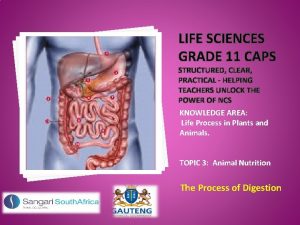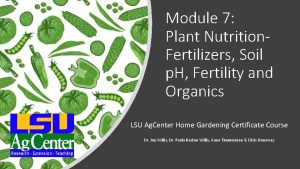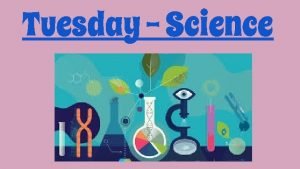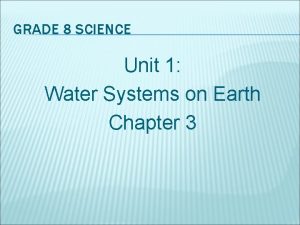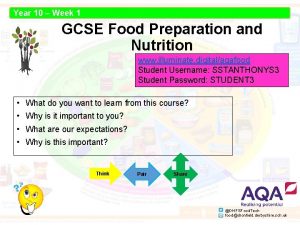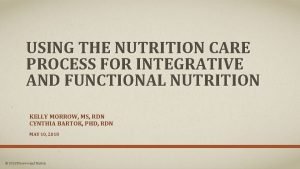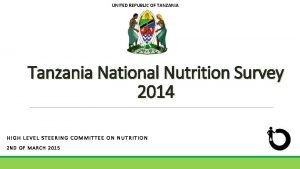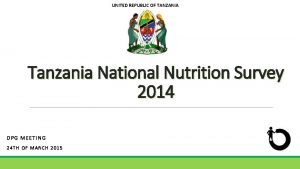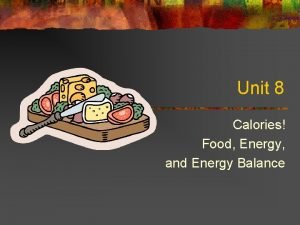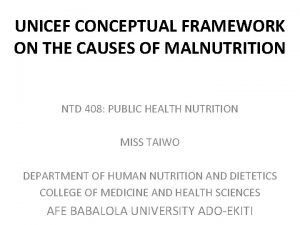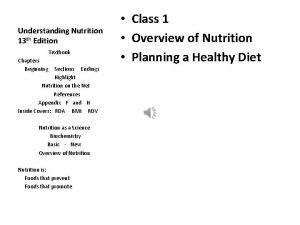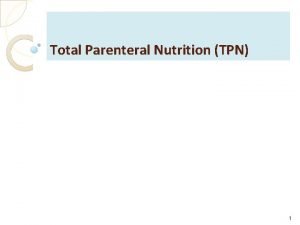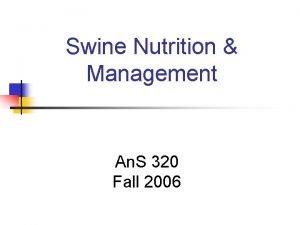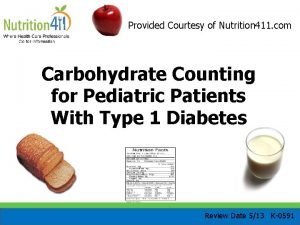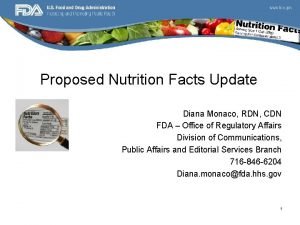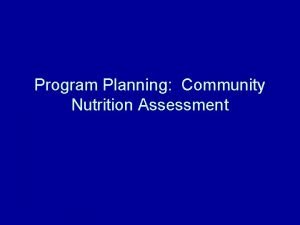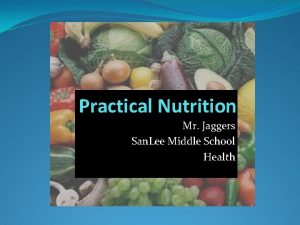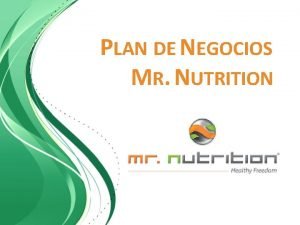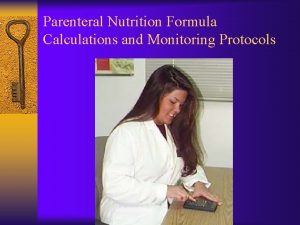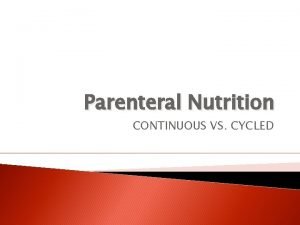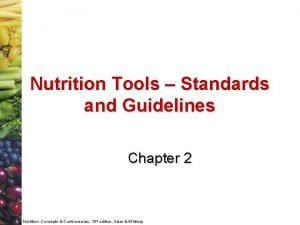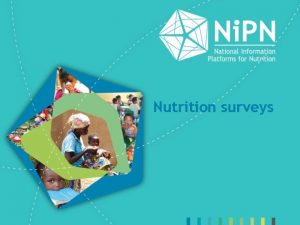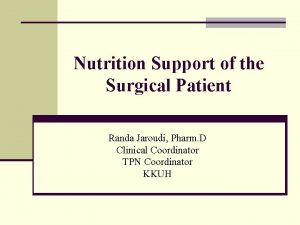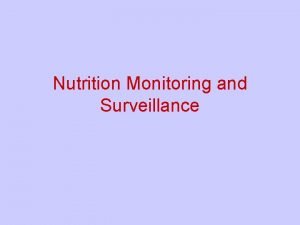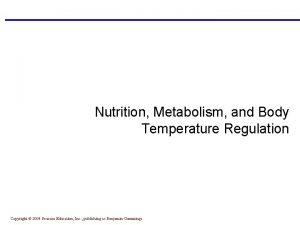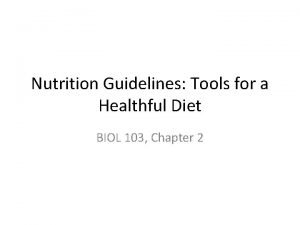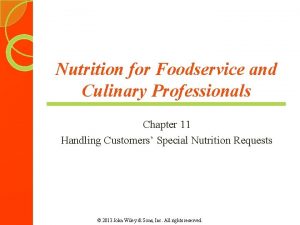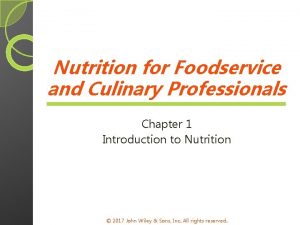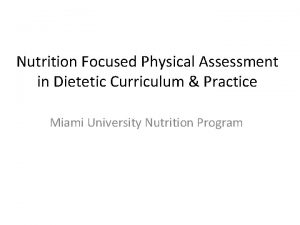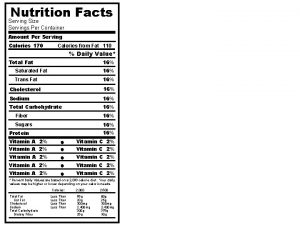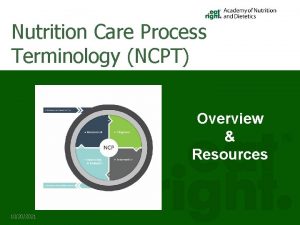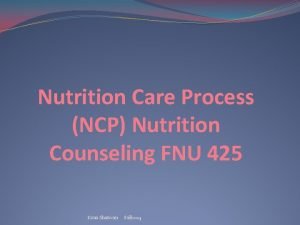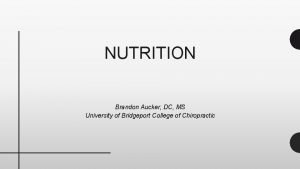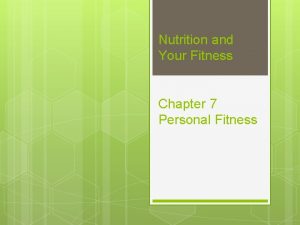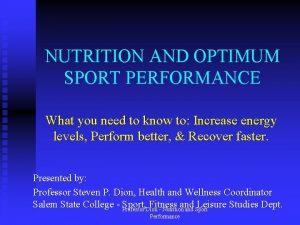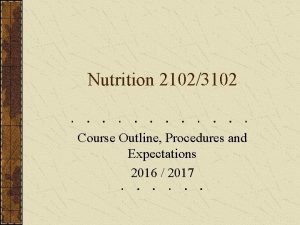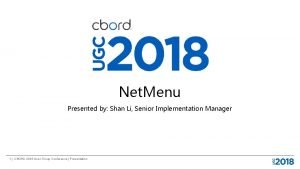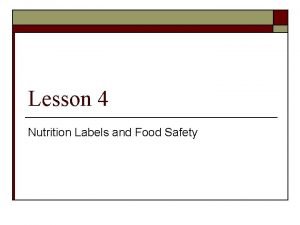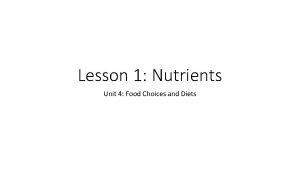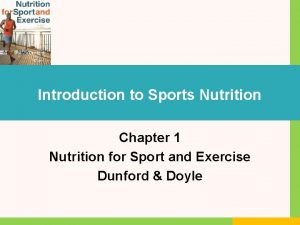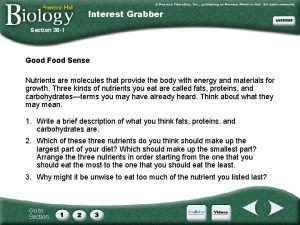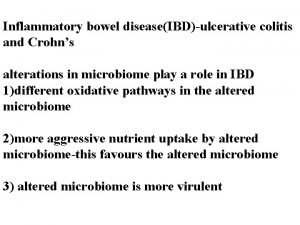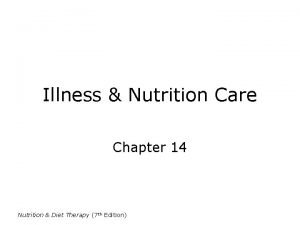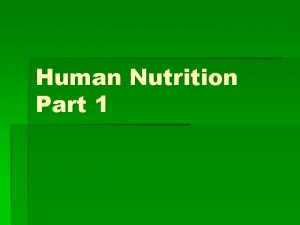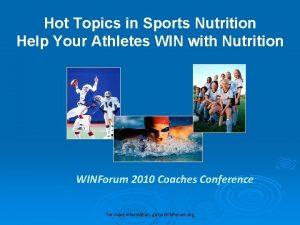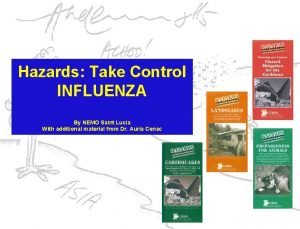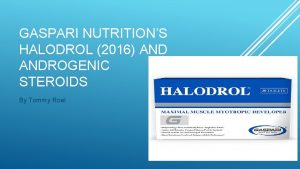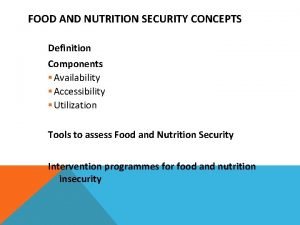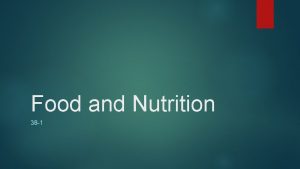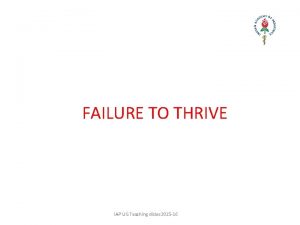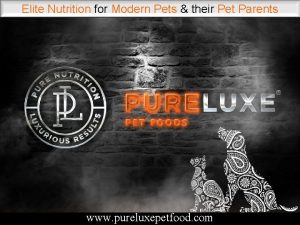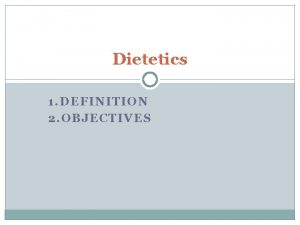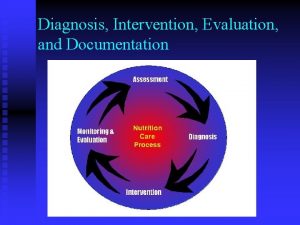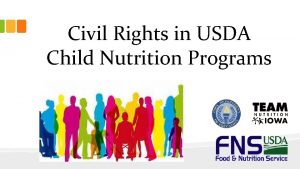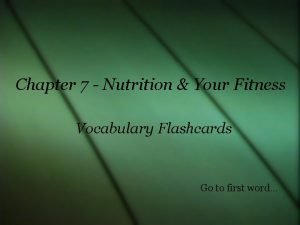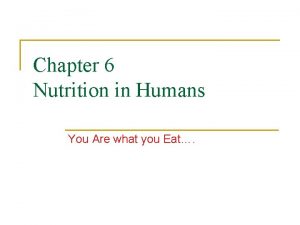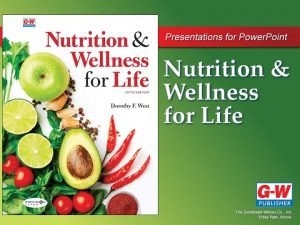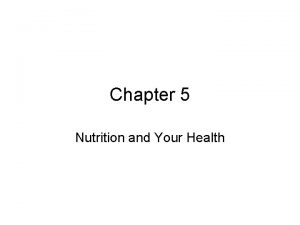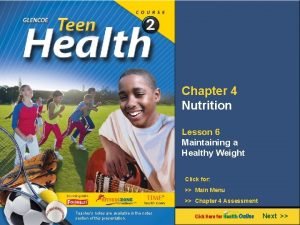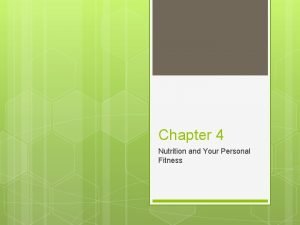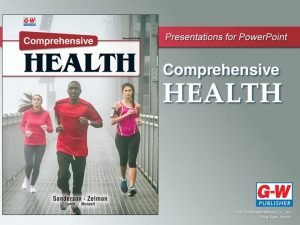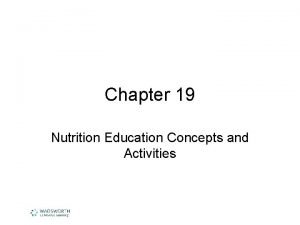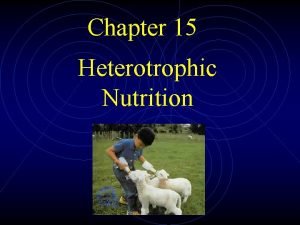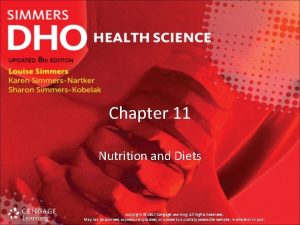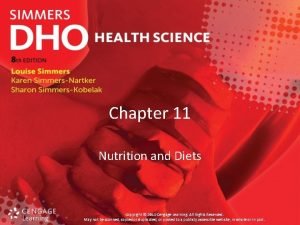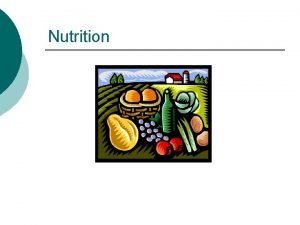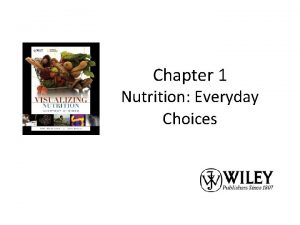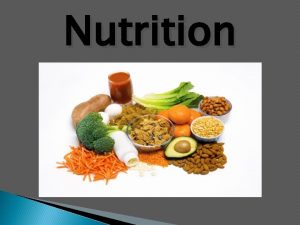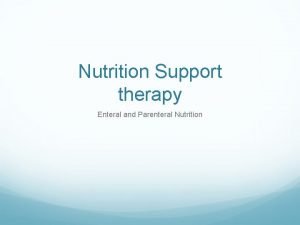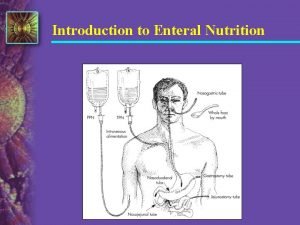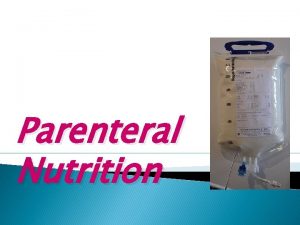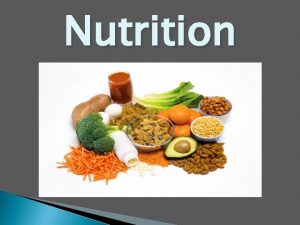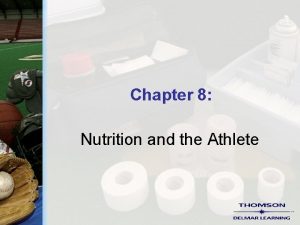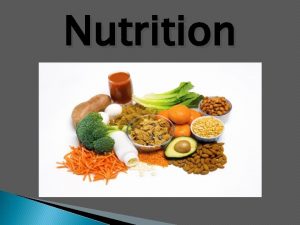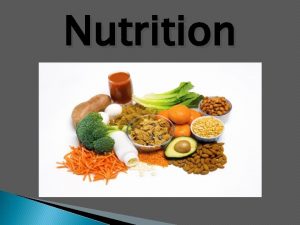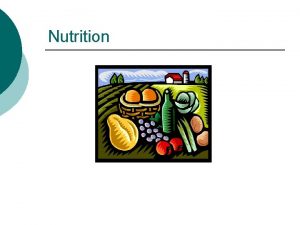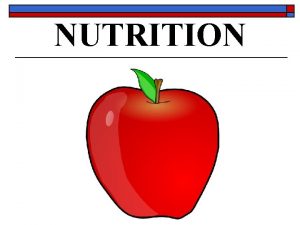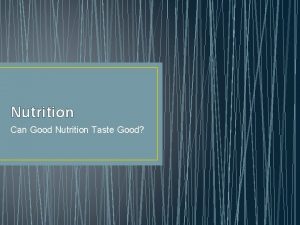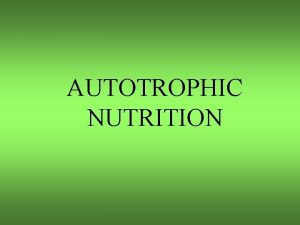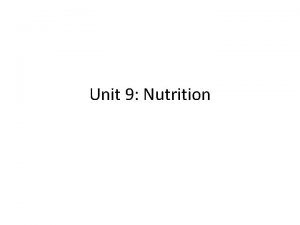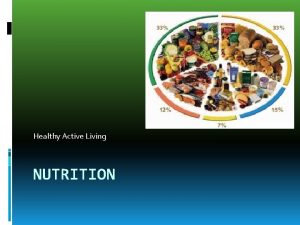Intro to Nutrition Mrs WeimerVeterinary Science Intro A


























































































- Slides: 90

Intro to Nutrition Mrs. Weimer-Veterinary Science

Intro – A Grassy Buffet • Imagine for a moment that you are trapped on a small deserted island with little other than grass and a freshwater spring. – There are no animals whatsoever, or plants other than the grass itself. • Could you survive for very long? • Could a cow survive for very long? • TPS Why is there a difference?

Nutrition & Energy • In nature, all living organisms must be able to acquire the molecules from which their cells are built and energy in which to operate their cells. • Plants, because of photosynthesis, can acquire all of their energy needs from the sun, water, and air through photosynthetic sugar production (GLUCOSE) – Animals, because they lack chloroplasts in their cells, cannot do this.

Classes of Animals • Four primary groups of digestive tracts exist among animals to process the energy captured in plants (or in other animals that eat those plants): – Monogastrics (humans, pigs, dogs): one simple stomach that secretes acid – Avian (birds): consists of a crop (where food is stored and soaked), a proventriculus stomach (similar to monogastrics) and a gizzard, in which grit or stones act like our teeth do to pummel food into smaller sizes. – Ruminant (cattle, deer): a multi-chambered stomach ferments dense forage into a more digestible substance before absorption. – Post-gastric fermenters/pseudo-ruminants (horse, rabbits): bacteria in the cecum (large intestine) ferment and break down any plant material not digested in the stomach.


Feeding Ruminants

Ruminant Dietary Nutrition • The most important job of a farmer or a rancher is to adequately provide for the nutritional needs of their cattle. – All other needs are secondary to the daily need for proper nutritional care – All other needs (with the exception of air) are not as immediate or pressing as the need for high quality food and water. – An animal without quality food or water can very quickly die. – An animal without quality food or water is a neglected and abused animal.

WATER REQUIREMENTS

Water • Cattle without access to water on a summer day can die from heat stroke after only a few hours – In winter, water is equally important • Water is necessary for regulation of body temperature, growth, reproduction, lactation, digestion, lubrication of joints, eyesight, and as a cleansing agent. • Limiting water intake can depress animal performance more quickly and drastically than any other nutrient deficiency. – Source: North Dakota State Univ.

Estimated daily water intakes (gallons per head per day) Dry Cows, Monthly Lactating Bred Cows, Month Average Temp Cows and Heifers Bulls ---------------------------(�F) - - gallons per head per day - January 36 11. 0 6. 0 7. 0 February 40 11. 5 6. 0 8. 0 March 50 12. 5 6. 5 8. 6 April 64 15. 5 8. 0 10. 5 May 73 17. 0 9. 0 12. 0 June 78 17. 5 10. 0 13. 0 July 90 16. 5 14. 5 19. 0 August 88 16. 5 14. 0 18. 0 September 78 17. 5 10. 0 13. 0 October 68 16. 5 8. 5 11. 5 November 52 13. 0 6. 5 9. 0 December 38 11. 0 6. 0 7. 5 ------------------------------------------------------- Source: North Dakota State Univ. Adapted from GPE-1400, Water Requirements for Beef Cattle.

Water requirements of growing and finishing beef cattle (gallons per head per day). Table 2. Water requirements of growing and finishing beef cattle (gallons per head per day). --------------------------------------Growing Cattle Finishing Cattle -----------------------------Month Avg. Temp. 400 lb 600 lb 800 lb 1000 lb 1200 lb --------------------------------------(�F) - - - - gallons per head per day - - - - - January 36 3. 5 5. 0 6. 0 5. 5 7. 0 8. 5 9. 5 February 40 4. 0 5. 5 6. 0 7. 5 9. 0 10. 0 March 50 4. 5 6. 0 7. 0 6. 5 8. 0 9. 5 10. 5 April 64 5. 5 7. 0 8. 5 8. 0 9. 5 11. 0 12. 5 May 73 6. 0 8. 0 9. 5 9. 0 11. 0 13. 0 14. 5 June 78 6. 5 8. 5 10. 0 9. 5 12. 0 14. 0 16. 0 July 90 9. 5 13. 0 15. 0 14. 5 17. 5 20. 5 23. 0 August 88 9. 0 12. 0 14. 0 17. 0 20. 0 22. 5 September 78 6. 5 8. 5 10. 0 9. 5 12. 0 14. 0 16. 0 October 68 5. 5 7. 5 9. 0 8. 5 10. 0 12. 0 14. 0 November 52 4. 5 6. 0 7. 0 6. 5 8. 0 10. 5 December 38 4. 0 5. 0 6. 0 7. 0 8. 5 9. 5 ----------------------------------------------------------------------------- Source: North Dakota State Univ. Adapted from GPE-1400, Water Requirements for Beef Cattle.

Access to Water • Cows given free access to water will produce more milk and more butterfat than cows allowed to drink only twice a day. • The same animal will consume different levels of water at different physiological states. – For example, a pregnant or lactating animal will consume more than an non-pregnant, nonlactating animal. • Source: North Dakota State Univ.

Cleanliness • Stale water can cause reduced water consumption - all water troughs should be cleaned frequently. – Livestock should never be forced to drink dirty or contaminated water. • Dirty water is a host for disease organisms. – Disease can spread rapidly if animals drink from the same trough, so sick animals should be isolated from the trough and the trough cleaned and disinfected. – A good disinfectant is dilute bleach solution after the trough has been thoroughly cleaned. – Sprinkling baking soda into the fountain periodically may reduce algae growth. • Source: North Dakota State Univ. ritchiefount. com

Cleanliness • Have an elevated base around automatic waterers. – Make the base wide enough so animals can easily put their front legs on it when they are drinking, but not their hind legs. – Animals will not normally place only their hind legs on this base and therefore will not defecate in the water. • Source: North Dakota State Univ.

Checking for Dehydration • Signs of dehydration or lack of water are tightening of the skin, loss of weight, and drying of mucous membranes and eyes. • In cattle, the eyes will appear sunken and dull. • In lactating dairy animals, dehydration will cause milk production to nearly stop. medical-dictionary. thefreedictionary. com • One way to check for dehydration is by skin tenting. – Pull the skin and hold a moment. – Release and count the seconds until the fold disappears. – On a dehydrated animal, the skin will stand for several seconds (like bread dough) • Source: North Dakota State Univ.

FEEDING REQUIREMENTS

Feeding Challenges • Feeding cattle is never simple – the needs of cattle change with age, with productivity, and with weather. • Furthermore, each animal is different and no one feeding ration will equally meeting the needs of all animals in a herd even under similar circumstances. • Feeds must be adjusted to the changing needs of cattle and re-checked regularly. research. vet. upenn. edu

Component’s of a Cow’s Diet • A cow, like any living organism needs five key ingredients in her diet – – – Energy Protein Vitamins Minerals Water ecocentricblog. org • To acquire these elements, a cow’s diet typically contains the following key ingredients: 1) forages, 2) energy concentrates, and 3) protein supplements. • Source: Univ of Minnesota Extension

Forages • Forages are typically thought of as the hay/pasture/grassy portion of a cow’s diet. • Forages are not as energy dense as concentrates and most of the energy in a forage is in the form of cellulose. – However, immature forages can be more energy-dense • Source: Univ of Minnesota Extension swiderskiequipment. com

Forages • Categories of common forages – Legumes and grasses (alfalfa, haylage) – These forages are excellent sources of protein, calcium, and other minerals if harvested and stored properly • As they mature, legumes and grasses decrease in energy and protein and increase in fiber (which reduces the digestibility of the food) Source: carolvaage. net – Terms: hay – cut and dired grass or alfalfa; haylage = fermented cut hay – Corn Silage - an excellent source of energy for dairy cattle - cows will eat large amounts of this feed. • Corn silage requires protein and mineral supplementation to be balanced for high milk production. – Terms: corn silage – fermented chopped corn leaves/stalks – Pasture – has the advantage of eliminating feed handling and manure hauling. Sourcecompletefeed. net • Additional grain is needed for high-producing cows. • As quantity and quality of pasture changes during the summer, cattle need to be supplemented with stored forages and other feeds – Source: Univ of Minnesota Extension Source pasturegrass-seed. com

Energy Concentrates • Naturally, a ruminant would not need much more than grass in their diet (e. g. imagine the millions of buffalo that ate little other than grasses on the Great Plains). – However, the energy demands of domesticated cattle are much greater, requiring sources of supplemented energy. • Seed grains are the most traditional source of energy concentrate. • Breaking the seed coat increases digestion. – Cows will eat more grain if it is coarse-textured and processed because it will be more palatable. – Fine grinding of grain can increase digestibility , but can also lower milk fat percent and cause rumen acidosis. – Too coarsely-ground feed will not be completely digested; up to 30% may pass completely through a cow undigested. • Source: Univ of Minnesota Extension aragriculture. org

Examples of Feed Concentrates • Corn – corn is the most widely fed feed concentrate. Corn can be fed in several ways – – 1. Whole ear – feeding a whole ear of corn provides more fiber but will also have proportionally less energy and is less digestible Source: ebirdseed. com – 2. Corn, shelled – shelled corn grain is the most commonly fed kind of corn. It is simply the kernels of corn fed straight to the cow. Because it is a dense source of energy, improper feeding can quickly lead to disorders. – 3. High moisture corn – this is corn that is harvested with 24%+ moisture so that it can ferment in the silo. It can be harvested sooner, reduces the expense of drying it, is very palatable to the cow, and requires less labor to produce. Source: cornstoverguide. com • Source: Univ of Minnesota Extension Source: NDSU. edu

Examples of feed concentrates (cont) • Cottonseed - a medium protein, high fat, high fiber, and high energy feed. It is a low-cost by-product of the cotton industry – Whole cottonseed is white and fuzzy, while de-linted cottonseed is black and smooth in appearance. – The amount fed should not exceed 7 pounds per cow per day. Source: edcotcoopgin. com • Corn-gluten – a relatively high fiber, medium energy, medium protein byproduct of the corn wet milling industry. – Source: Univ of Minnesota Extension Source: tradekorea. com

Examples of feed concentrates (cont) • Oats contain 15 percent less energy but 20 to 30 percent more protein than shelled corn. – The advantage of adding oats to dairy rations is that it adds fiber and bulk, and may help maintain rumen function. • Molasses (cane and beet sugar) is used primarily to enhance the taste of the ration. extension. uidaho. edu – The amount used should be limited to 5 to 7 percent of the grain mix to avoid rumen disorders and prevent clogging of equipment • Fat - several kinds of animal and vegetable fats or oils are available for feeding agway. com – Total added fat in diets should not exceed 4 percent (DM basis) with animal, vegetable or rumen inert fats individually not exceeding 2 percent. • Source: Univ of Minnesota Extension kentshowfeeds. com

Protein Supplements • The requirement for protein is dependent upon the age of the cow, stage of production, and level of production. Protein requirements, like energy, are additive during any point in the cows production cycle • Cattle protein requirements are met by two basic sources, the feedstuffs that they consume and the microorganism that populate the rumen. • Dietary protein component can be divided into two categories: – Degradable intake protein (DIP) – Undegradable intake protein (UIP). • Source: Basic Nutrient Requirements of Beef Cows robertscottbell. com farmwest. com

A Tale of Two Proteins • The DIP component is the protein from the diet that is digested in the rumen, utilized by rumen microorganisms, and ultimately becomes bacterial (microbial) protein. – This is the protein that a cow gets from the bacteria; the cow is the ‘second’ one to get the protein. • The UIP component is the protein fraction of the diet that is not digested in the rumen and that thereby "escapes or bypasses" the rumen. This is also called “bypass protein”. – The UIP protein may then be digested and absorbed in the small intestine – it bypasses the microbes and goes directly to the cow. • Together, the bacterial protein and UIP fraction comprise the metabolizable protein available for the cow to meet her protein requirement. – Source: Basic Nutrient Requirements of Beef Cows lasatergrasslandbeef. blogspot. com

celsias. com Protein Supplements • Soybeans are an excellent source of crude protein and fat for cattle. ca. uky. edu – Cows should be adjusted to beans gradually to avoid diarrhea and offfeed. – Roasting, extruding, or other heat processing reduces anti-protein factors and urease activity and increases UIP value of the soybeans. • Bloodmeal is dried blood from animal processing plants. – Bloodmeal is high in true protein, UIP and the amino acid lysine. – Do not feed in diets high in moisture, as palatability can become a problem • Brewers grain, a by-product of the fuel ethanol and beer industries, contains 70 to 80 percent water. kval. com – On a dry matter basis, brewers grains are high in protein and a fair source of energy. • Cottonseed Meal – made from oil of whole cottonseed, this produce is very palatable to cows but varies in protein content. • Fishmeal includes bones, head, trimmings, and fish parts. Fish oil is high in protein but reduces fiber digestion in the rumen. – Source: Univ of Minnesota Extension allproducts. com

Understanding Nutrients: Vitamins 11/6/2020 28

What caused this condition? 11/6/2020 29

I. Vitamins • A) Organic substances necessary in small amounts • B) Required for normal growth and maintenance of life • C) Function as catalyst in metabolic processes • D) 16 essential vitamins 11/6/2020 30

II. Types of Vitamins • A) Fat Soluble – 1. can be stored in the body – 2. daily intake not required – 3. Examples: A, D, E, K • B) Water Soluble – 1. Not stored in the body – 2. Must supplement regularly – 3. Examples: C, Complex B vitamins 11/6/2020 31

III. How Animals Obtain Vitamins • A) Complex ruminants synthesize vitamins in the rumen • B) Sources of Vitamins – 1. Vit A = Green forages and corn – 2. Vit D = Sun-cured forages – 3. Vit E = Whole grain, green forage, high quality hay – 4. Vit K = Green leafy forage, fish meal – 5. Vit C = Supplemented in feed ration 11/6/2020 32

Vitamin A Deficiency • Calves are stillborn or weak • Blindness • Neurological diseases • Diarrhea

Vitamin D Deficiency • Rubber Beaks-Birds • Rickets

Vitamin E Deficiency • Crazy Chicken Disease • Heart Wall breakdown

Vitamin K Deficiency • Blood clotting deficiency • Bleeding Disorder

Vitamin C Deficiency • Inhibits the formation of: – Collagen – Carnitine – Hormones – Amino acids – What would be one issue with this?

The Importance of Minerals 11/6/2020 38

The Importance of Minerals Animal Minerals A. Inorganic substances that animals need in small amounts B. Major (macro)--Needed in larger amounts C. Micro Minerals- Needed in small amounts 11/6/2020 39

Major/Macro Minerals Calcium 1. Functions a. Bone and teeth development b. Essential for lactating animals and laying hens c. Nerve and muscle function d. Maintain acid-based balance of body fluids 2. Deficiency symptoms a. Rickets b. Broken bones c. Slow growth d. Milk fever (Hypocalcaemia) 11/6/2020 40

Major/Macro Minerals Calcium 3. Sources a. Grains, grain by-products, straw, dried manure, grasses, protein supplements from plants b. Forages (grasses, legumes) c. Fish meal, milk, citrus pulp 4. Calcium Toxicity a. Decreased absorption of other minerals b. Calcification of soft body tissues c. Kidney stone formation (Note: The calcium-phosphorus ratio in the feed must be kept between 1: 1 to 2: 1 for proper utilization of both minerals. ) 11/6/2020 41


Major/Macro Minerals Phosphorus 1. Functions a. b. c. d. e. f. Bone and teeth growth and development Appetite Milk and egg production Reproduction Conversion of carotene to vitamin A Vitamin D utilization a. b. c. d. e. Lameness Stiffness of joints Lowered appetite Reduced rate of gain Breeding problems 2. Deficiency symptoms 11/6/2020 43

Major/Macro Minerals Phosphorus 3. a. b. c. d. 11/6/2020 Sources Feeds such as wheat bran, meat scraps, tankage, fish meal, dried skim milk Legume and grass pastures Cereal grains and by-products Mineral supplements 44


Major/Macro Minerals Salt (sodium and chlorine) 1. Functions a. Maintain osmotic pressure in body cells b. Maintain neutral p. H level in body tissues c. Muscle and nerve activity d. Formation of hydrochloric acid in digestive juices 2. Deficiency symptoms a. Lack of appetite b. Unthrifty appearance c. Reduced growth d. Lowered reproduction e. Eating soil 11/6/2020 46

Major/Macro Minerals Salt (sodium and chlorine) 3. Sources a. Hay salt (loose) b. Salt block 4. Toxicity a. Cause—Restricted water with salt intake b. Symptoms—Staggering gait, blindness, nervous disorder, hypertension 11/6/2020 47


Major/Macro Minerals Potassium 1. Functions a. Osmotic pressure b. Maintain acid-base balance of body fluids c. Muscle activity d. Carbohydrate digestion 2. Deficiency symptoms a. Slow growth rate b. Reduced feed consumption c. Muscle weakness d. Diarrhea 11/6/2020 49

Major/Macro Minerals Potassium 3. Sources a. Forages b. Grains and concentrates 4. Toxicity a. Diarrhea b. Tremors c. Heart failure 11/6/2020 50

Major/Macro Minerals Magnesium 1. Functions a. Activate enzyme systems in body b. Proper maintenance of nervous system c. Carbohydrate digestion d. Utilization of zinc, phosphorus and nitrates e. Normal skeletal development 2. Deficiency symptoms a. Muscle spasms and convulsions (grass tetany) b. Hyperirritability 11/6/2020 51

Major/Macro Minerals Magnesium 3. Sources a. Most rations contain enough b. Can be mixed with salt or supplement c. If diet is low, magnesium will be pulled from bones 11/6/2020 52


Sulfur Major/Macro Minerals 1. Functions a. Amino acids make-up b. Lipid metabolism c. Carbohydrate metabolism d. Energy metabolism 2. Deficiency symptoms a. Unthriftiness b. Slow growth 3. Sources a. Forages—Especially legumes b. Water 11/6/2020 54

Micro Minerals Iron 1. Functions a. Hemoglobin formation b. Oxidation of nutrients in cells 2. Deficiency symptom—Anemia 3. Sources a. Grains b. Forages c. Trace-mineralized salt with iron 11/6/2020 55

Micro Minerals Manganese 1. Functions a. Utilization of phosphorus b. Assimilation of iron c. Reduction of nitrates d. Amino acid and cholesterol metabolism e. Synthesis of fatty acids 2. Deficiency symptoms a. Swollen and stiff joints b. development c. Sterility d. e. Reduced ovulation f. g. Deformed, weak or dead offspring h. Appetite loss, slow gain i. j. Pinkeye 11/6/2020 Abnormal bone Delayed estrus Abortion Rough hair coat 56

Micro Minerals Manganese 3. Sources a. Trace-mineralized salt b. Most rations are sufficient 11/6/2020 57

1. Functions Micro Minerals Copper a. b. c. d. e. f. g. Hemoglobin formation Activate some enzyme systems Hair development and pigmentation Wool growth Bone development Reproduction Lactation a. c. e. g. h. Severe diarrhea b. Slow growth (caused by anemia) Swelling of joints d. Bone abnormalities Weakness at birth f. Breathing difficulty Lack of muscle coordination Sudden death 2. Deficiency symptoms NOTE: Goats HAVE to have copper, but it is toxic in Sheep! 11/6/2020 58

Micro Minerals Copper 3. Sources—Most livestock feeds have more than needed 4. Toxicity a. Levels—Above 50 ppm b. Symptoms—Anemia, jaundice Pic of a goat 11/6/2020 59

Micro Minerals Zinc 1. Functions a. Normal development of skin, hair, wool, bones and eyes b. Prevent parakeratosis c. Promote healing d. Enzyme systems e. Protein synthesis f. Metabolism g. Insulin 2. Deficiency symptoms a. Parakeratosis (rough, thick skin in swine) b. Thick skin on neck, muzzle, back of ears (cattle) c. Slow wound healing d. Poor appetite, slow growth e. Swelled hocks and knees, stiff gait f. Inflammation of nose and mouth tissues 3. Source—Trace-mineralized salt 11/6/2020 60

Micro Minerals Molybdenum 1. Functions a. Enzyme xanthine oxidase (1) Milk (2) Body tissues (3) Uric acid (poultry) b. Stimulates rumen organisms 2. Source—Most normal rations are adequate 3. Toxicity a. Diarrhea b. Poor growth c. Loss of hair color d. Bleached mucous membranes e. Lameness f. Joint abnormalities g. Osteoporosis h. Death 11/6/2020 61

Micro Minerals Selenium 1. Functions a. b. Vitamin E absorption Part of enzyme glutathione peroxidase a. b. c. d. White muscle disease Retained placenta in ruminants Low fertility in ruminants Diarrhea a. b. c. Selenium injections Roughages Mixed into ration (not authorized by FDA for all animals) 2. Deficiency symptoms 3. Sources 11/6/2020 62

Micro Minerals Selenium 4. a. Toxicity Acute–Intake of accumulator plants over short period (1) Labored breathing (2) Abnormal movement and posture (3) Prostration (4) Diarrhea (5) Death b. Chronic—Blind staggers—intake of limited amount of accumulator plants over a longer period of time (1) Impaired vision (2) Wandering (3) Stumbling (4) Death 11/6/2020 63

Micro Minerals Selenium (1) (2) (3) (4) (5) Chronic alkali disease--Intake of grains or grasses with more than 5 mg selenium/K over a long period Liver cirrhosis Lameness Hoof malformations Hair loss Emaciation 11/6/2020 64

Micro Minerals 1. 2. 3. 11/6/2020 Cobalt Functions a. Synthesis of vitamin B 12 b. Rumen bacteria growth Deficiency symptoms a. Poor appetite/general malnutrition b. Weakness c. Anemia d. Slow growth e. Decreased fertility f. Lower wool and milk production Sources- supplement 65

Micro Minerals Iodine 1. Function--Thyroxine production 2. Deficiency symptoms a. Goiter b. Weak or dead offspring c. Offspring born without hair d. Infected navels at birth 3. Sources a. Iodized salt b. Ration supplement 11/6/2020 66

1. 2. 3. 4. Micro Minerals Fluorine Functions a. Prevent cavities b. Slow down osteoporosis Deficiency- is rare; supplementing the ration is not recommended Sources a. Water b. Forages Toxicity (an accumulative poison) a. Tooth enamel loss b. Uneven, excessive wearing of teeth c. Bones--thick, soft, weak d. Lameness e. Poor appetite, poor gains, weight loss f. Rough hair coat g. Lowered milk production 11/6/2020 67

Intro to why we use Pearson Squares Nutrient and Feed Requirements 11/6/2020 68

What Affects An Animal’s Nutritional Requirements? 1. The Specific Animal and Their Age 2. The Animal’s Use and Function - Light/Moderate/Heavy Work -Maintenance -Breeding Stock, Lactating, Stage of Gestation -Etc. 3. Environmental Conditions: -Temperature, Wind -Environmental Stress Factors 4. Quality and Availability of Feed 11/6/2020 69

All factors need to be considered in determining feed used in ration to meet the animal’s nutritional needs. 11/6/2020 70

Nutrient Requirements for Body Maintenance 1. Body Maintenance: Requires nutrients to supply the body to sustain normal operations. 2. There is no gain or loss in weight or production. 3. Maintenance feed formulas provide nutrients for: 1. Body tissue repair 2. Control of body temperature 3. Energy for vital organs 4. Water balance maintenance 4. Feedlot animals may use 30 -40% of their nutrients for maintenance. 5. Mature breeding animals may need 90% of their feed for maintenance. 11/6/2020 71

Nutrient Requirements for Growth Important Nutrients Required for Growth: 1. Energy 2. Protein- Essential in muscle development 3. Minerals 4. Vitamins 11/6/2020 72

Nutrient Requirements for Reproduction Two Categories: 1. Gamete Production 2. Fetal Growth in Uterus 1. Nutrients required by a growing fetus are much greater in the last trimester of pregnancy. -Similar requirements as a young animal after birth 2. Females can temporarily withdraw nutrients from their body to support the fetus. But this will lower their reproductive ability. 11/6/2020 73

Nutrient Requirements for Lactation Milk Production requires: 1. Protein 2. Minerals 3. Vitamins 4. Energy Calcium and phosphorus are the two most important minerals needed for lactation. 11/6/2020 74

Nutrient Requirements for Work 1. The primary requirement is energy Research Each Situation: -Each animal’s situation determines its nutritional needs. -Nutritional charts/information are available 11/6/2020 75

PEARSON SQUARE Balancing a Ration 11/6/2020 76

Pearson Square • It shows the proportions or percentages of two feeds to be mixed together to give a percentage of the needed nutrient 11/6/2020 • Useful tool for simplifying and balancing of rations 77

2000# of feed is needed to feed a 100# growing hog. • A feeding standards table shows that an 18% crude protein ration is needed. • Corn and Soybean Meal (SBM) are selected as feeds. 11/6/2020 Pearson Square 78

• A feed composition table shows Corn has 8. 9% crude protein 11/6/2020 Pearson Square SBM has 44. 4% crude protein 79

• How much corn and soybean meal need to be mixed together for 2000# of feed? 11/6/2020 Pearson Square 80

11/6/2020 Pearson Square Step 1 -Draw a 1 - to 2 inch square. Place diagonal lines across the square. 81

• Step 2 – Write the percentage of crude protein needed by the animal in the center of the square where the diagonal lines cross 11/6/2020 Pearson Square 18. 0 82

Pearson Square • Corn • 8. 9% 11/6/2020 • Step 3 –Write the feeds to be used at each corner. Place the percent of crude protein in the feeds after the name of the feed 18. 0 • SBM • 44. 4% 83

Corn 26. 4 parts • Step 4 – Subtract the • 8. 9 % corn smaller of the numbers from the larger numbers. (This involves crude 18. 0 protein needed by the animal and that provided by the feed. ) Write the • SBM 9. 1 parts difference in the • 44. 4% SBM opposite corners 11/6/2020 Pearson Square 84

• Step 5 – The numbers at the two right corners are parts of the two feed ingredients that are needed. • 26. 4 parts corn • +9. 1 parts soybean meal (SBM) • 35. 5 total parts 11/6/2020 Pearson Square 85

Pearson Square 26. 4 parts corn 35. 5 total parts 11/6/2020 • Corn • 8. 9% 18. 0 • SBM 9. 1 parts SBM • 44. 4% 35. 5 total parts • 86

• Step 6 – The percentage of each feed needed in the ration can be found by dividing the number of parts by the total parts, then multiply by 100. 11/6/2020 Pearson Square • 26. 4/ 35. 5 =. 744 x 100 = 74. 4% corn • 9. 1/ 35. 5 =. 256 x 100 = 25. 6% sbm 87

• Corn • 8. 9% 26. 4 parts corn 35. 5 total parts 74. 4% 11/6/2020 Pearson Square 18. 0 • SBM 9. 1 parts SBM • 44. 4% 35. 5 total parts 25. 6% 88

• Step 7 – The amount of each feed ingredient for a large batch of feed is determined by multiplying the percentage of each by the total amount of feed desired 11/6/2020 Pearson Square 89

Pearson Square • 2000# x. 744 = 1488 # Corn • 2000# x. 256 = 512 # SBM 11/6/2020 • Our batch of feed = 2000 # ( 1 ton) 2000# of feed @ 18% Crude Protein 90
 Mrs gren c
Mrs gren c They are mrs garcia and mrs castro
They are mrs garcia and mrs castro They are mrs garcia and mrs castro
They are mrs garcia and mrs castro Mrs. darling was ___________ of mrs. s.
Mrs. darling was ___________ of mrs. s. Describe your favourite subject english
Describe your favourite subject english Human nutrition grade 11
Human nutrition grade 11 Natural fertilizer disadvantages
Natural fertilizer disadvantages Chapter 1 introduction to forensic science and the law
Chapter 1 introduction to forensic science and the law Science mrs gren
Science mrs gren Grade 8 science water systems quiz
Grade 8 science water systems quiz Social science vs natural science
Social science vs natural science Branches of science diagram
Branches of science diagram Natural science vs physical science
Natural science vs physical science Applied science vs pure science
Applied science vs pure science Rapid change
Rapid change Science fusion introduction to science and technology
Science fusion introduction to science and technology Why environmental science is an interdisciplinary science
Why environmental science is an interdisciplinary science Windcube lidar
Windcube lidar Hard and soft science
Hard and soft science Digital illuminate aqa food preparation and nutrition
Digital illuminate aqa food preparation and nutrition Nutrition care process
Nutrition care process Tanzania national nutrition survey 2018
Tanzania national nutrition survey 2018 Tanzania national nutrition survey 2018
Tanzania national nutrition survey 2018 Biobeyond unit 8 counting calories
Biobeyond unit 8 counting calories Conceptual framework of malnutrition
Conceptual framework of malnutrition Understanding nutrition 13th edition rental
Understanding nutrition 13th edition rental 1 tpn
1 tpn Swine nutrition management
Swine nutrition management Specialized nutrition support
Specialized nutrition support Nutrition411
Nutrition411 Monaco nutrition facts sugar
Monaco nutrition facts sugar Community nutrition assessment
Community nutrition assessment Prime astaxanthin
Prime astaxanthin San lee middle school
San lee middle school Mr nutrition el palo
Mr nutrition el palo Tpn calculations
Tpn calculations Tpn cycling
Tpn cycling Healthypeopleenergy
Healthypeopleenergy Objectives of nutrition
Objectives of nutrition Complication of parenteral nutrition
Complication of parenteral nutrition Nutrition words
Nutrition words Nutrition monitoring definition
Nutrition monitoring definition Homeostasis mechanisms for regulation of body temperature
Homeostasis mechanisms for regulation of body temperature Learning outcomes of photosynthesis
Learning outcomes of photosynthesis Ul tolerable upper intake level
Ul tolerable upper intake level Chapter 11 culinary nutrition
Chapter 11 culinary nutrition Nutrition for foodservice and culinary professionals
Nutrition for foodservice and culinary professionals Abbott nutrition focused physical assessment
Abbott nutrition focused physical assessment Nutrition focused physical assessment
Nutrition focused physical assessment Stacy's pita chips nutrition label
Stacy's pita chips nutrition label Nutrition care process terminology
Nutrition care process terminology Diabetes pes statement
Diabetes pes statement Nutrition diagnosis domains
Nutrition diagnosis domains University of bridgeport nutrition
University of bridgeport nutrition Kelsey carbonetta
Kelsey carbonetta Optimum sports nutrition
Optimum sports nutrition Nutrition 3102
Nutrition 3102 Netmenu cbord
Netmenu cbord Datingoo
Datingoo Food and nutrition unit 4
Food and nutrition unit 4 Definition of sports nutrition
Definition of sports nutrition Section 38-1 food and nutrition
Section 38-1 food and nutrition Ppn vs tpn
Ppn vs tpn Diet care logo
Diet care logo Stages of human nutrition
Stages of human nutrition Hot topics in sports nutrition
Hot topics in sports nutrition Nemo 3a nutrition
Nemo 3a nutrition Halodrol gaspari
Halodrol gaspari Food and nutrition unit 4
Food and nutrition unit 4 Healthy food scavenger hunt
Healthy food scavenger hunt Nutrition security definition
Nutrition security definition 38-1 food and nutrition
38-1 food and nutrition Failure to thrive iap
Failure to thrive iap Extreme elite nutrition dog food
Extreme elite nutrition dog food High performance nutrition
High performance nutrition Objectives of nutrition and dietetics
Objectives of nutrition and dietetics Dri nutrition
Dri nutrition Pes statement for obesity
Pes statement for obesity Civil rights training certificate
Civil rights training certificate Civil rights in child nutrition programs
Civil rights in child nutrition programs Fitness chapter 7
Fitness chapter 7 Holozoic nutrition
Holozoic nutrition Dri nutrition
Dri nutrition A saturated fatty acid holds all the hydrogen atoms it can.
A saturated fatty acid holds all the hydrogen atoms it can. Lesson 6 anorexia nervosa and bulimia
Lesson 6 anorexia nervosa and bulimia Chapter 4 nutrition and your personal fitness
Chapter 4 nutrition and your personal fitness Chapter 4 body weight and composition answer key
Chapter 4 body weight and composition answer key Foods used in nutrition activities should be nutrient-dense
Foods used in nutrition activities should be nutrient-dense Types of heterotrophic nutrition
Types of heterotrophic nutrition Test chapter 11 nutrition and diets
Test chapter 11 nutrition and diets Chapter 11 nutrition and diets
Chapter 11 nutrition and diets





